WBBSE 9th Class Social Science Solutions Geography & Environment Chapter 8 West Bengal
WBBSE 9th Class Social Science Solutions Geography & Environment Chapter 8 West Bengal
West Bengal Board 9th Class Social Science Solutions Geography & Environment Chapter 8 West Bengal
WBBSE 9th Class Geography & Environment Solutions
Salient points – At a Glance
- West Bengal is the only state of India which extends from the Bay of Bengal to the Himalayas.
- At present, there are 28 states and 8 union territories in India.
- West Bengal ranks fourth in total population and second in population density among the 28 states of India.
- West Bengal shares common boundaries with three independent countries namely, Bangladesh, Bhutan and Nepal and five Indian states namely, Assam, Sikkim, Bihar, Jharkhand and Odisha. Though the state of Tripura does not share a common boundary with West Bengal, yet it is regarded as a neighbouring state of West Bengal.
- Presently, there are 23 districts in West Bengal which are grouped into 5 administrative divisions- (1) Jalpaiguri division, (2) Malda division, (3) Bardhaman division, (4) Medinipur division, (5) Presidency division.
- The most newly formed districts of West Bengal are Purba Bardhaman and Paschim Bardhaman which were formed on 7 April 2017 after the bifurcation of the former Bardhaman district.
- West Bengal is mainly divided into three physiographic divisions- (1) Northern hilly region, (2) Western plateau region and (3) Plain region.
- Northern hilly region of West Bengal is the extended part of eastern Himalayas. This mountainous region covers the major part of Darjeeling district except Siliguri subdivision, Kalimpong district and northern part of Alipurduar district.
- Singalila range extends along the boundary of Darjeeling and Nepal. Sandakphu, one of the peaks of Singalila range (3665 m) is the highest peak of West Bengal.
- The plain land at the foothills of northern hilly region is known as Terai. The slope of the land is from north to south. The land at the east of Terai is known as Dooars or Duars.
- Geologically western plateau region is a part of the Chotanagpur Plateau.
- Gorgaburu of Ayodhya hill is the highest peak (677 m) of western plateau region.
- Old alluvium region of North Bengal is called Barind or Barendrabhumi. Red soil can be seen in this region.
- Scattered marshy land of northern plain is locally known as Tal.
- The flat land between the western plateau region and Bhagirathi-Hooghly river is known as Rarh region.
TOPIC – A
Location and Administrative division of West Bengal
Long Answer Type Questions
- In 1947 when India was divided, Bengal was divided too. One-third of the land area of Bengal formed West Bengal, while the rest went on to form East Pakistan. The Boundary Commission was formed in 1947 under the leadership of the English lawyer Radcliff Brown. He marked the boundary between West Bengal and Bangladesh.
- Religion was the major basis of the partition of Bengal. The majority non-Muslims formed West Bengal and Bangladesh was formed where Muslim community was the majority. At that point of time in 1947, the total area comprising West Bengal was 78,000 sq. km.
- The Islampur sector of Bihar was annexed to the district of West Dinajpur of West Bengal in 1947.
- The French colonies of Chandannagar and Gaurhati were included in West Bengal.
- The Mahananda Corridor was formed after including the Bengali-speaking region of eastern Purnea district of Bihar (in accordance with the law of re-construction of states).
- A self-governed region of Darjeeling Gorkha Hill Board (‘Parshad’) was formed including the hilly region of Darjeeling district of West Bengal in 1988.
- In 1986, the 24 Parganas district of West Bengal was divided into two districtsNorth 24 Parganas and South 24 Parganas.
- In 1992, the district of West Dinajpur was divided as Uttar Dinajpur and Dakshin Dinajpur. The corridor named ‘Teen Bigha’ was leased to Bangladesh, that included the district of Cooch Behar, the bordering regions of Makaliganj and Kuchilbari.
- In 2002, the district of Medinipur was divided into two districts-Paschim Medinipur and Purba Medinipur.
- The latest change in the administrative boundary of West Bengal was the formation of Alipurduar district (from the Jalpaiguri district) on 25 June 2014.
- Kalimpong district was formed from Darjeeling district on 14 February, 2017.
- Jhargram district was formed from Paschim Medinipur district on 4 April, 2017 and Purba and Paschim Bardhaman districts were formed on 7 April, 2017 by splitting the Bardhaman district.
- Nepal: It is located to the north-west of West Bengal with a total area of about 147181 sq.km. The capital of Nepal is Kathmandu. The world’s highest peak, Mt. Everest (8848 m) is located in Nepal. The main river of this country is Kaligandaki.
- Bhutan: Bhutan is located to the north of West Bengal with an area of about 38394 sq.km. Its capital is Thimphu. The highest peak of Bhutan is Kula Kangri and its longest river is Manas.
- Bangladesh: Bangladesh is located on the eastern side of West Bengal. Its area is 148460 sq. km. Dhaka is the capital of Bangladesh. The highest peak of Bangladesh is Keokradong and its longest river is Padma-Meghna.
- Bihar: Bihar is located to the west of West Bengal. Its area is 94163 sq. km. The capital of Bihar is Patna. Besides Ganga (which is the main river of Bihar), other rivers which flow through this state are Kosi, Gandak, Son, etc.
- Jharkhand: It is located on the western side of West Bengal covering an area of 79714 sq. km. Its capital is Ranchi. The main river of this state is Mayurakshi. Jharkhand is also called the ‘Mineral State of India’.
- Assam: It is located to the east of West Bengal and its total area is 78438 sq. km. The capital of Assam is Dispur. The main river here is Brahmaputra. The famous Majuli island, which is the largest riverine island in the world has formed over this river.
- Odisha: It is located to the south-western side of West Bengal with an area of 155707 sq. km. Its capital is Bhubaneshwar. The main river of this state is Mahanadi. Puri is a famous religious as well as tourist centre of Odisha.
- Sikkim: It is located on the northern part of West Bengal covering an area of 7096 sq. km. Its capital is Gangtok. The highest peak of Sikkim is the Kangchenjunga and the longest river is Teesta.
- Area: West Bengal comprises about 2.7% of the total area of India.
- International border: West Bengal shares international border with Bangladesh, Nepal and Bhutan. Pertaining to the length of international border, West Bengal ranks second in India.
- Population: In terms of population, West Bengal ranks fourth in the country and comprises about 7.5% of the total population of India.
- Population density: West Bengal has the second highest population density (1029 persons per sq. km) just after Bihar.
- Agricultural production: Among all the states of India, West Bengal occupies the top position in production of rice, jute and fish. In case of potato and tea production, West Bengal ranks second whereas for coal. mining, it occupies the seventh position.
- Industry: West Bengal has a significant position in case of iron and steel industry, engineering industry and tea industry.
- Commercial position: Kolkata, the capital of West Bengal, is the second largest city in India (in terms of population). Apart from this, it is also the largest commercial centre in eastern India. Kolkata has the largest commercial port and an international airport.
- Diverse physical features: West Bengal is the only state in India where both the Himalayan mountain range and the Bay of Bengal are found. Apart from these, flood plains, plateaus, rivers & islands are also found here.
Short Explanatory Answer Type Questions
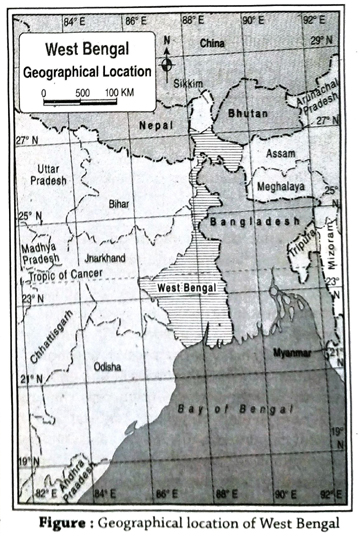
- The cold winds from the northern part are not able to reach West Bengal because of the location of Himalaya which acts as a barrier in the north. It also protects us from foreign invasion.
- The Bay of Bengal, located to the south of West Bengal protects the state from foreign invasion and also helps in international trade. The Kolkata and Haldia ports play a vital role in carrying out trade via sea.
- The seasonal variation and rich biodiversity of West Bengal are a result of its geographical location.
Short Answer Type Questions
Multiple Choice Type Questions [MCQ type]
Write the correct answer from the given alternatives
Very Short Answer Type Questions
Fill in the blanks with suitable words
If the statement is true, write ‘T’ and if false, write ‘F’ against the following
Answer in one or two words
TOPIC – B
Physiography
Long Answer Type Questions
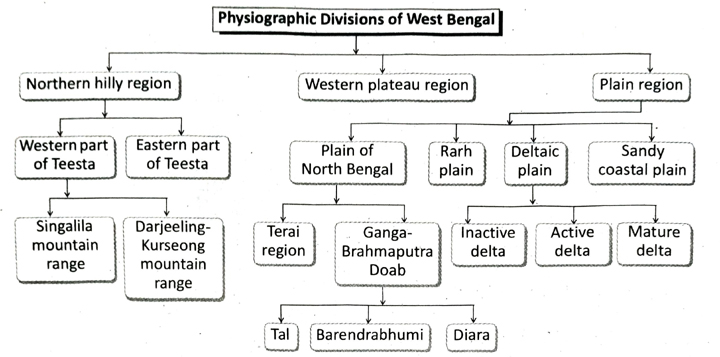
- This region is a part of the Eastern Himalayas.
- The average height of this region is approximately 2600m-2700 m.
- The northern hilly region has several canyons and high peaks and so is inaccessible in general. The slope of this region is from north to south.
- The western part of Teesta: The western part of the Teesta river has two important Himalayan mountain ranges- (1) Singalila mountain range and (2) Darjeeling-Kurseong mountain range. Three main peaks of Singalila mountain range are located in the Darjeeling district. These areSandakphu (3630 m, the highest peak of West Bengal), Phalut (3596 m) and Sabargram (3543 m). In the Darjeeling-Kurseong mountain range, one of the most prominent peak is Tiger Hill (2573 m). Another notable peak of this range is Senchal (2615 m).
- The eastern part of Teesta: The average elevation of the mountain range in eastern part of Teesta river is comparatively less. The highest peak in this region is Rishila (3121 m). Apart from this, other peaks in this region are Renigango (1885 m), Sanchuli (1726 m) etc. The Buxa-Jayanti Hills, Durpin Dara Ridge are also located in the eastern part of Teesta river.
- The average elevation of western part of this plateau region is higher (600 m) than that of the eastern part (100 m).
- The land here is rocky and full of pebbles.
- The region is mainly composed of granite and gneiss rocks. However, some parts of the plateau region is also made of rocks like sandstone, shale, etc.

- The elevation of this region is not very high.
- This region has formed by the deposition of silt carried by rivers.
- Plain of North Bengal: This plain region extends from the foothills of the Darjeeling Himalayas in the north to the left bank of the Ganga river in the south. The slope of this region is from north to south. In the north the foothills of the Himalayan range is called the Terai and the remaining region is called Ganga-Brahmaputra Doab. This region is known by different names in different areas. For example, the low-lying regions of Jalpaiguri, Cooch Behar, Uttar Dinajpur is known as ‘Tal’, the eastern parts. of the Malda and Dakshin Dinajpur districts, composed of old alluvial soil and laterite soil is called ‘Barendrabhumi’ and the western part of the Malda district composed of new alluvial soil, which is extremely fertile is known as ‘Diara’.
- Rarh plain: The intermediate region between the plateau region in the west and Bhagirathi-Hooghly in the east is called the Rarh plain. The eastern parts of Bankura and Paschim Bardhaman; northern and eastern parts of Birbhum; the entire district of Purba Bardhaman, Purba Medinipur, Howrah, Hooghly and western part of Murshidabad fall under the Rarh plains. The western part of this plain region is slightly undulating and red soil is found in that region. The slope of this area is from west to east.
- Deltaic plain: The entire districts of Nadia, North and South 24 Parganas, Howrah, Hooghly and the eastern part of Murshidabad district fall under the deltaic plain region. This is a low-lying plain and is a part of the Gangetic deltaic plain. The northern part of this plain is an inactive, delta, the middle part is a mature delta whereas the southern part, i.e., the Sundarbans is an active delta.
- Sandy coastal plain: The sandy coastal plain is located along the coast of Bay of Bengal in Purba Medinipur. The slope of this region is from north to south. Many sand dunes are found in this coastal plain.
- The entire Purulia district, adjacent districts of Paschim Medinipur, Jhargram, Bankura, Paschim Bardhaman and western part of Birbhum constitute the undulating western plateau region.
- From the geological point of view, this area is an extended part of the Chotanagpur plateau region. This is one of the most ancient regions of West Bengal and is made up of mainly old igneous and metamorphic rocks.
- The western part of this plateau region is higher than the eastern part. (75 m). The highest peak of this region is Gorgaburu (677 m). The slope of the land here is from west to east.
- This plateau region is scattered with isolated which are made of hard rocks. For example, Ajodhya Hills and Baghmundi Hills located in the western part of the Purulia district.
- Gorgaburu of the Ajodhya Hills in Purulia is the highest peak of this whole plateau region. Panchet Hills (490 m) is located in the northern part and Bhandari Hills (433 m) is located in the southern part of the Purulia district.
- The eastern part of the western plateau gradually slopes down over the districts of Paschim Medinipur, Bankura, Jhargram, Paschim Bardhaman and western region of Birbhum. Small hills like Belpahari in Paschim Medinipur and Susunia Hills (440 m) are located in the Western plateau region.
- Terai or Dooars Plain: (1) This region comprises of the southern part of Alipurduar district, major part of the southern region of Jalpaiguri district and Siliguri subdivision of Darjeeling district. (2) The Himalayas in the north meets the plain here with gentle slope and creates almost a sloping plain-like landform. (3) Scattered mounds of pebbles and rocks and some wetlands are found in this region. (4) This land slopes from north to south. This region receives heavy rainfall and hence remains wet for most part of the year.
- Ganga-Brahmaputra Doab Plain: The plain land lying between the rivers Ganga and Brahmapurta is further classified into the following categories-
- Tal: The area between the rivers Kalindi and Mahananda in the Malda district and the low-lying area in the districts of Jalpaiguri, Cooch Behar and Uttar Dinajpur is collectively known as ‘Tal’. Numerous wetlands and marshes are seen here.
- Barind or Barendrabhumi: The area encompassing the eastern parts of Dakshin Dinajpur and Malda districts which is undulating and is made up of old alluvial soil and laterite soil is known as ‘Barind’ or ‘Barendrabhumi’.
- Diara: This area which is composed of new alluvial soil and lies to the south of Kalindi river, flowing along the southwestern part of Malda district is called ‘Diara’.
- Inactive delta: The northern part of the deltaic plain encompassing the districts of Nadia and Murshidabad is known as inactive delta. This is because the rivers here do not deposit silt anymore and so the process of delta formation has almost ceased to exist. In this region ox-bow lakes, creeks and wetlands are found.
- Mature delta: This region stretches from the southern part of the inactive delta to the northern part of the Sundarban region. It comprises of Kolkata, North 24 Parganas, South 24 Parganas, Howrah, Hooghly and some parts of Purba and Paschim Medinipur. The rivers flowing over this region still deposit some amount of silt during floods. Thus, formation of delta continues to some extent.
- Active delta: The southern part of South and North 24 Parganas fall under the active delta region. This deltaic region is called active since the rivers of the Sundarbans are still carrying out depositional work, i.e., siltation and thereby help in the process of delta-formation.
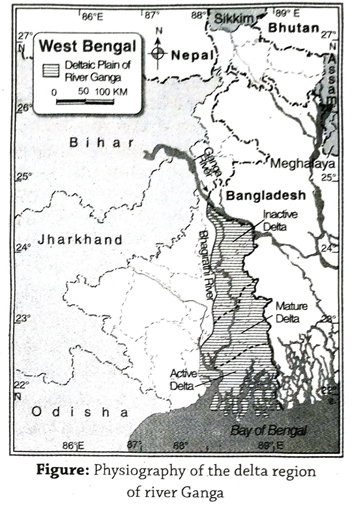
Short Explanatory Answer Type Questions
- Plain relief: The plain relief is ideal for agriculture as well as transport and communication.
- Moderate climate: The moderate climate and adequate rainfall are the causes of high density of population in this region.
- Fertile alluvial soil: The soil of deltaic region is made up of alluvial soil (silt) which is very fertile and suitable for agriculture.
- Development of transport: The area is covered by an extensive network of railways, roadways.
- Job opportunities: This region is welldeveloped in both agriculture and industry and so job opportunities are plenty here.
Short Answer Type Questions
Multiple Choice Type Questions [MCQ type]
Write the correct answer from the given alternatives
Very Short Answer Type Questions
Fill in the blanks with suitable words
If the statement is true, write ‘T’ and if false, write ‘P against the following
Answer in one or two words
TOPIC – C
River and Water Resources
Long Answer Type Questions
- Rivers of North Bengal: The rivers of North Bengal are snowfed. They originate from the Himalayan region and flow from north to south according to the slope. The rivers are Teesta, Jaldhaka, Mahananda, Sankosh, Raidak, Torsa, etc.
- Teesta: It originates from the Jemu glacier in the Sikkim Himalayas. Teesta is the main river of North Bengal, flows through the districts of Darjeeling and Jalpaiguri and drains into the Jamuna in Bangladesh.
- Jaldhaka: It rises from the hilly regions of the Sikkim-Bhutan border and flows through the districts of Jalpaiguri and Cooch Behar before draining into the Jamuna in Bangladesh.
- Mahananda: This river rises in the Darjeeling Himalayas, flows south and drains into the Ganga. Balason river is its tributary.
- Ganga and its tributaries running through the central part: The main river of West Bengal is the Ganga. It emerges from the Gangotri glacier near Gomukh in Uttarakhand and traverses a great distance before entering into West Bengal through Dhulian in Murshidabad. Here, the river gets divided into two parts, one is Hooghly river in West Bengal and the other enters as Padma in Bangladesh. The Hooghly river flows south and drains into the Bay of Bengal. The distributaries of Ganga and Padma are Ichamati, Churni, Jalangi, etc.
- Rivers of western plateau and Rarh region: These rivers are rain-fed. The slope of the land is from west to east and southeast and the rivers originating from the Chota Nagpur Plateau flow accordingly. The rivers of this region are-Damodar, Dwarkeswar, Shilabati, Kangsabati, Ajoy, Mayurakshi, Dwarka, etc.
- Damodar: The river rises from the Khamarpat Hills in the Palamau district of Jharkhand and drains in the Bhagirathi-Hooghly. One of its distributaries, Mundeswari drains into the Rupnarayan river.
- Rupnarayan: It is the combined flow of rivers Dwarakeswar and Shilabati, both rise from the western plateau region and flow south-west. Rupnarayan drains into the Hooghly river.
- Other rivers: Other important rivers of this region include the Kangsabati, Ajay, Mayurakshi, Dwarka, etc.
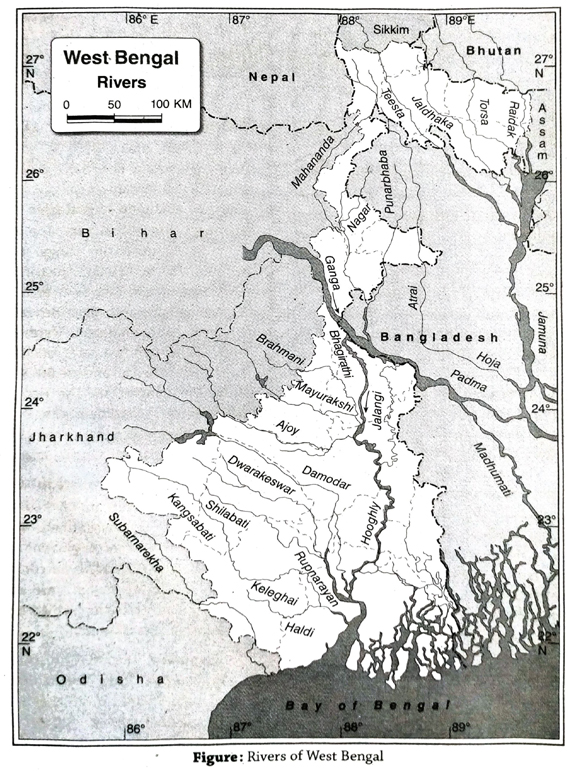
- Rivers of Sundarbans: Numerous rivers of this region are tide-fed and flow towards the west. Saptamukhi, Matla, Raimangal, Bidyadhari, etc., are the rivers of Sundarbans.
- Rivers of Kanthi region: The rivers of this region are tide-fed. Rasulpur and Champa are the rivers of the sandy area of Kanthi.
- Teesta: It is the most important river of North Bengal. Teesta originates from the Jemu glacier, flows through the districts of Darjeeling and Jalpaiguri and finally drains into the Jamuna river of Bangladesh.
- Jaldhaka: This river originates from the mountainous terrains of the Sikkim-Bhutan border, flows through the districts of Jalpaiguri and Cooch Behar and finally meets the Jamuna river in Bangladesh.
- Mahananda: This river originates near the Mahaldiram Hills of the Himalayan range and flows southwards. It finally flows into the the Ganga and its main tributary Balasun river.
- Others: Some of the other notable rivers of North Bengal are Sankosh, Raidak and Torsa.
- Damodar: It originates from the Khamarpat Hills of Palamau district in Jharkhand and joins river Hooghly downstream. One of its distributaries, Mundeswari, drains into the Rupnarayan. Damodar was a flood-prone river before the conceptualisation of the Damodar Valley Project, and was thus known as the ‘Sorrow of Bengal’.
- Kasai or Kangsabati: It originates from the Ajodhya Hills of Purulia district and flows to the south-east to meet river Keleghai. The combined flow of these two rivers is river Haldi, which meets river Hooghly. Kumari river is a tributary of this river.
- Dwarakeswer and Shilai or Shilabati: The combined flow of these two rivers near Ghatal in Paschim Medinipur is known as Rupnarayan. It then meets river Hooghly near Geonkhali in Purba Medinipur.
- Mayurakshi: It originates from the Chota Nagpur Plateau and flows through the state of Jharkhand. Later it enters the Birbhum district of West Bengal and joins river Bhagirathi at the end. Right bank tributaries of river Mayurakshi include Bakreswar, Kopai and left bank tributaries are Brahmani and Dwarka.
- Ajoy: It originates from the Chota Nagpur Plateau and flows through southern boundary of Birbhum district and then meets river Bhagirathi near Katwa in Purba Bardhaman district.
- Others: Another important river of this region is Subarnarekha. It originates from the Chota Nagpur Plateau in Jharkhand and flows through the southern part of Jhargram district of West Bengal and Odisha and then drains into the Bay of Bengal.
- Damodar: This river originates from the Khamarpat Hills of the Palamu district in Jharkhand. It flows through the western plateau and the Rarh Plain and drains into the Bhagirathi-Hooghly river. Mundeswari, a distributary of Damodar flows into the Rupnarayan river.
- Rupnarayan: The rivers Dwarekeswar and Shilai (or Shilabati) meet near Ghatal to form the Rupnarayan river. This river finally drains into the Hooghly river near Geonkhali.
- Others: Some other notable rivers of this region are-Kangsabati, Ajoy, Bakreswar, Mayurakshi and Dwarka.
Short Explanatory Answer Type Questions
- Snowfed rivers: Most of rivers are snowfed but some rivers have originated form springs.
- Follow the slope of land: Rivers flow towards south and south-east according to the slope of the land.
- Entry into Bangladesh: Most of the rivers of this region ultimately enter Bangladesh and join the river Jamuna (Brahmaputra). Though some of rivers also meet the river Padma.
- Perenniality: Being snowfed, the rivers carry water throughout the year and are thus perennial rivers.
- Presence of strong currents: The rivers flow rapidly in mountaineous regions and have strong currents. So they form narrow ‘v’ shaped valleys known as gorges in their course and these strong water currents are tapped for the hydroelectric power generation.
- Proneness to flood: The rivers are prone to flood as they enter the plains from the mountainous regions.
- The rivers are the tributaries of the Bhagirathi-Hooghly river.
- The rivers originate from Chota Nagpur Plateau region.
- The rivers are rainfed and so they remain dry except during the rainy season.
- The rivers flow from west to east or southeast.
- Rainfed river: Most of the rivers of the plateau area are fed by rain water, and so it has water only during the rainy season.
- High temperature: The temperature of the summer season is about 40°C and hence the rate of evaporation is also very high during this time which leads to the drying up of waterbodies.
- Impact of dams: Various dams and reservoirs have been built in this area, which store the water and also regulate the water flow in rivers. Thus, in the lower courses of the river, the amount of water gets reduced as a result of this.
- Agricultural purpose: The state of West Bengal is agriculture oriented. Irrigational practices depend mainly on rivers, canals, etc.
- Transportation purpose: The river Bhagirathi-Hooghly is an important component of West Bengal’s transportation system.
- Drinking water and other household purpose: The purified water is utilised for drinking purpose. Other household chores such as cleaning, washing, cooking also involve the use of water.
- Industrial purpose: Water from rivers, canals, etc., contribute mostly to the development of the industrial sector and the process of manufacturing in factories. For example, many industries have developed on the banks of the river Hooghly.
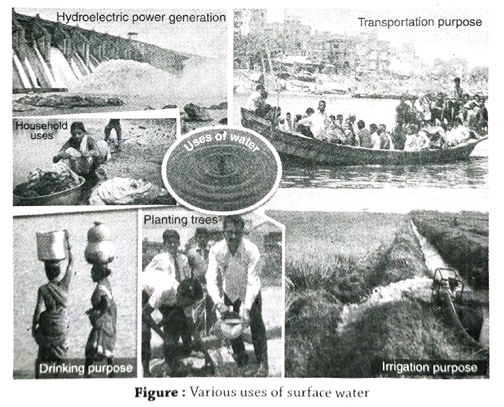
- Plantation: Water is used in social afforestation and agricultural afforestation. Huge amounts of water is used for planting trees in the western plateau region.
- Generation of electricity: The production of hydroelectric power is done from river dams. For example, from the waters of Mython, Panchet, Tilaiya dam on the river Damodar, hydroelectricity is produced.
Short Answer Type Questions
Multiple Choice Type Questions [MCQ type]
Write the correct answer from the given alternatives
Very Short Answer Type Questions
Fill in the blanks with suitable words
If the statement is true, write ‘T’ and if false, write ‘F against the following
Answer in one or two words
TOPIC – D
Climate
Long Answer Type Questions
- Change of seasons: The main characteristic of the climate of West Bengal is season change. Summer, monsoon, autumn and winter are the four main seasons of West Bengal, that change in a cyclical way. Apart from that, before the arrival of winter, dewy season is observed that is known as late autumn, while spring marks the beginning of summer.
- Extensive impact of tropical monsoon wind: In summer the hot south-western monsoon winds and in winter the dry north-eastern monsoon winds blow over the state. These two winds bring hot-humid summers and cold-dry winters in West Bengal, respectively.
- Opposite direction of winds: In West Bengal, the direction of wind in summer is opposite to the direction of wind in winter.
- Wet summer and dry winter: Generally rainfall occurs in summer, so the summer is basically wet and humid. On the other hand, winter is dry in West Bengal. But a little amount of rainall occurs due to western disturbances.
- Northern region is rainfall prone: As a result of the south-west monsoon winds, West Bengal receives heavy rainfall in its Northern Himalayan region. The hilly regions of West Bengal receives an average. rainfall of 400 cm annually.
- Entire West Bengal except the mountainous region has moderate type of climate: As the northern part of West Bengal is a mountainous area, summers are pleasant here but winters are bitterly cold. In the rest of West Bengal the annual range of temperature is not very high. Pleasant climate prevails in the plains and coastal western regions. The plateau area (especially Purulia) experiences high summer temperatures. In Darjeeling district of northern mountainous region, summer temperature (16°C) being low, winter clothes are required in the summer as well. Temperature rapidly decreases here at night.
- Change of season: The climate of West Bengal can be divided into 4 seasons according to the onset and retreat of these two wind systems. These are-(1) pre-monsoon or summer season, (2) monsoon or rainy season when the south-west monsoon winds are active, (3) retreat of the south-west monsoon winds or autumn season, and (4) onset of north-east monsoon winds or winter season.
- Determine climatic characteristics: Not only the demarcation of seasons, but also the climatic characteristics of West Bengal are influenced by the nature of monsoon winds.
- Low temperature during winter: The northeast monsoon winds blow from the north towards the south during winter (from December to February). Since these winds are cold, the temperature drops in West Bengal and it is known as the winter season. Rainfall does not occur in this season as these winds are dry.
- High temperature during summer: The north-east monsoon winds start retreating from West Bengal from the end of February and the south-west monsoon winds arrive during the interim period (from March to May). As a result, the temperature rises, and this period is known as summer season.
- Excessive rainfall during rainy season: The south-west monsoon wind blows over West Bengal from June to September. Since this wind is moisture-laden, the sky is overcast and rainfall occurs. This season is called the rainy season or monsoon season.
- Clear sky during autumn: During October to November, the south-west monsoon winds retreat. As a result the sky becomes clear and temperature gradually decreases.
Short Explanatory Answer Type Questions
- Impact on body and mind: The change of season affects human body and mind heavily. For example, extreme hot weather brings tiredness and excessive cold temperature causes lethargy.
- Change in cultivation: Different crops are cultivated in different seasons. For example, vegetables grow well in winter. Winter is also ideal for cultivating ‘Rabi’ crops and rainy season is for ‘Kharif’ crops.
- Change in diet: The diet of human beings changes according to the season, because people consume seasonal fruits and vegetables available in the market.
- Change in biological processes: The duration of days and nights vary according to different seasons. Thus, the biological clock of human body changes accordingly.
- Impact on festivals and tourism: Durga puja, the main festival of West Bengal, is celebrated in autumn. Picnics, circuses, fairs etc. are held in winter. All these seasonal activities create employment, that affects human life. Season change also impacts tourism. For example, hilly regions attract more tourists during winter.
- Increase of diseases: Several diseases are caused due to season change. For example, cold and cough during rainy season, chicken pox in spring, etc., are seasonal diseases.
- Tropic of Cancer: Since the Tropic of Cancer (23½° N) passes through West Bengal, the state (except the mountainous region of Darjeeling) is, warm in nature.
- Monsoon winds: The moisture-laden south-west monsoon winds blow over West Bengal during the rainy season causing widespread rainfall. Again, the dry north-east monsoon winds blow over the state causing no rainfall. These winds are cold since they arrive from mountainous areas. Thus, West Bengal experiences cold weather devoid of rainfall during the winter months.
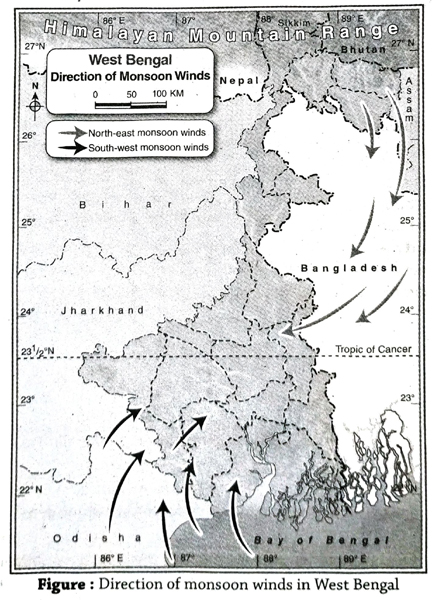
- Altitude of the land: There is an inverse relationship between altitude and temperature. With every 1000 metre of ascent, the temperature drops at the rate of 6.4°C and hence the temperature decreases with increase in altitude. Since the Himalayan mountain regions are greater in altitude as compared to the plains, they have much lower temperature.
- Location of the Bay of Bengal: Since the Bay of Bengal lies to the south of West Bengal, it has a moderate climate with no extreme temperature.
- Location of the Himalayan mountains: The Himalayas are aligned from west to east across the northern part of the state. On one hand, it is responsible for causing rainfall (relief or orographic rainfall), while on the other, it acts as a barrier and prevents the cold winds (northeast monsoon winds) from blowing over the state during the winter months.
Short Answer Type Questions
Multiple Choice Type Questions [MCQ type]
Write the correct answer from the given alternatives
Very Short Answer Type Questions
Fill in the blanks with suitable words
If the statement is true, write ‘T’ and if false, write ‘F against the following
Answer in one or two words
TOPIC – E
Soil and Natural Vegetation
Long Answer Type Questions
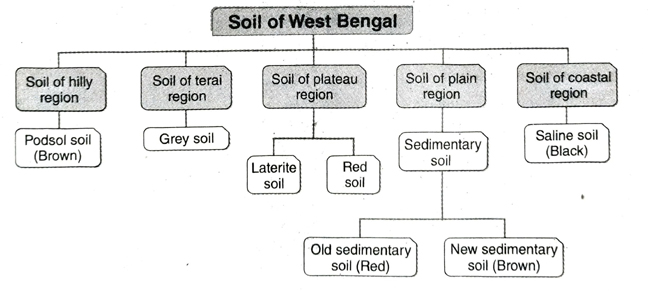
- Location: This type of soil mostly found in the districts of Darjeeling, Jalpaiguri, Alipurduar, parts of Cooch Behar, etc.
- Characteristics: (a) This is a type of podsol soil. (b) This soil is mostly brown in colour. (c) The fertility of this soil is medium.
- Crops produced: Tea, orange, cinchona, etc. are cultivated in this soil.
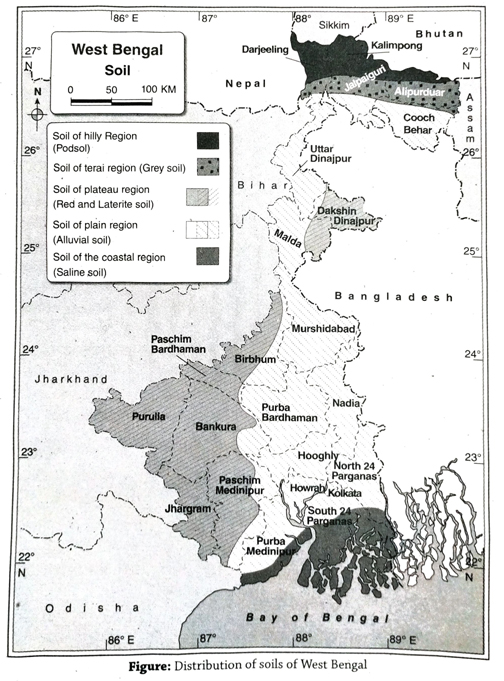
- Location: This type of soil is found at the foothills of the Himalayas.
- Characteristics: (a) This type of soil is full of pebbles. (b) This soil is grey in colour. (c) The soil fertility is medium.
- Crops produced: Paddy, wheat, tea, potato are cultivated in this soil.
- Location: This soil is mostly found in Purulia, Bankura, Birbhum, Paschim Bardhaman, Paschim Medinipur, Jhargram and Dakshin Dinajpur.
- Characteristics: (a) In this region, mostly two types of soil are foundlaterite soil at the west and red soil at the east. (b) Laterite soil is red in colour and hard as brick. This soil is infertile and the water holding capacity is very low. (c) Red soil is also red in colour. The texture of this soil is fine and iron content is very high. Water holding capacity of this soil is low and that is why, for cultivation irrigation is very important.
- Crops produced: Paddy (in a small amount), corn, potato, tobacco, etc. are the main crops produced.
- Location: This type of soil mostly found in Uttar Dinajpur, Murshidabad, Nadia, Purba Bardhaman, North and South 24 Parganas, Howrah, Hooghly, etc.
- Characteristics: (a) This type of soil is mostly acidic in nature. (b) This soil is mainly formed by the deposition of rivers. So, the amount of silt, sand and clay are high in this soil. (c) This is a fertile soil, mostly known as sedimentary soil or alluvial soil. (d) The old sedimentary soil is red in colour and less fertile. On the other hand, new sedimentary soil is brown in colour and more fertile.
- Crops produced: Paddy, wheat, jute, sugarcane, etc. are the main crops.
- Location: This type of soil is mainly found in the Sundarbans and Kanthi coastal regions in West Bengal.
- Characteristics: (a) This soil is saline in nature. (b) The texture of this soil is very fine. (c) Water holding capacity of this soil is low. (d) This soil is black in colour. and infertile in nature.
- Crops produced: In this soil the amount of salt is very high. That is why, with the help of rainwater harvesting the salinity of the soil is controlled that helps to cultivate crops like paddy (in a small amount), vegetables, coconut, betel nut, watermelon, etc.
Short Answer Type Questions
Multiple Choice Type Questions [MCQ type]
Write the correct answer from the given alternatives
Very Short Answer Type Questions
Fill in the blanks with suitable words
If the statement is true, write ‘T’ and if false, write ‘F’ against the following
Answer in one or two words
TOPIC – F
Agriculture
Long Answer Type Questions
- Monsoon-dependent agriculture: Agricultural practices of West Bengal are largely dependent on the south-west monsoon wind. The kharif crops are cultivated based on the arrival of monsoon rain. Thus crop cultivation is hampered because of the uncertainty of the monsoon rain.
- Intensive agriculture: Population density of West Bengal is very high. Therefore, the demand of food is also very high. That is why, intensive agriculture is practised in West Bengal.
- Labour-intensive agriculture: The agricultural practices of West Bengal are labour-intensive since use of machines is minimal. The farmers cultivate their fields with outdated implements like ploughs and bullocks.
- Livelihood-based agriculture: The agricultural practices of West Bengal are for the livelihood of the people. The cultivated crops are consumed by the farmers themselves since surplus is very less.
- Crop rotation system: The crop rotation system is followed to retain the fertility of the soil. A single piece of land is thus cultivated more than once to produce various crops.
- Importance of paddy cultivation: Since rice is the staple food of the people of West Bengal, paddy is cultivated in abundance. Moreover, the fertile silty soil of the delta regions as well as the warm and humid climate is conducive for paddy cultivation.
- Development of irrigation and cultivation of rabi crops: In winter, rabi crops are cultivated with the help of irrigation. The productivity of rabi crops is increased with the help of irrigation by wells, tubewells, and canals. The capacity of irrigation has been increased which facilitates productivity.
- Production of fishing and poultry farming besides crop cultivation: Since the main food of West Bengal comprises fish, egg, meat, etc., poultry-farming is gaining importance along with pisciculture besides the cultivation of crops.
- Agricultural development programmes: The development of agriculture has increased with the help of five year plans and 3-tier Panchayat Management System.
- Forecast of Green Revolution: After Green Revolution many modern measures have been taken in agricultural practice of West Bengal. It helps to increase production of crops in West Bengal.
- Primary tea producing regions: Best quality flavoured tea is produced in the Darjeeling district. Along the hilly slopes ranging between 900 m to 2000 m altitude, have been made terraces for tea plantations. The most important tea producers here are Happy Valley, Makaibari, Sukhiapokhri, Kurseong, Bijanbari, etc.
- Secondary tea producing regions: Some other tea plantations are seen in Kalimpong, Jalpaiguri and the foothills of the Himalayas in the district of Alipurduar. Tea is also produced in the foothills of Himalayas of the Dooars region. Important tea producing centre of Dooars are Mal, Binaguri, Madarihat, Chalsha, Naxalbari, Kumargram, Nagarkata etc.
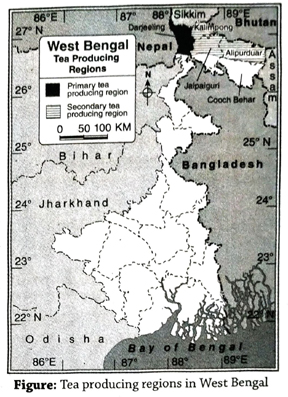
- Physical environment: The important factors are-
- Relief: Relief is an important factor for the cultivation of tea. Sloping land where water does not stand is required for tea cultivation and that is why hilly slopes are ideal locations. Since hilly soil areas are prone to erosion, terraces have been prepared along the contours for tea plantations.
- Climate: Hot and wet climate having a high amount of rainfall is necessary since they influence the flavour, colour and taste of tea. Rainfall ranging between 150 cm and 200 cm, and average annual temperature of 20°C -30°C and summer temperature of 27°C, is ideal for tea cultivation. Snowfall is harmful for tea plantations.
- Soil: Fertile, acidic, iron and manganese-bearing soils are ideal for tea cultivation. However, sufficient amounts of nitrogen, zinc and potassium are also needed.
- Man-made factors: Some of the important man-made factors are-
- Capital: Capital is needed for maintenance of tea gardens, labour wages, implements, fertilisers, pesticides etc.
- Labour: Skilled workers are required to pick tea-leaves. Large number of laboures are required for the tea processing work.
- Transport: Developed transport system is essential for exporting after processing it (since tea plantations are located in hilly areas).
- Others: Besides the above factors, advanced technology, demand for tea, administrative facilities, market etc., also influence production of tea.
Short Explanatory Answer Type Questions
- On the basis of season: On the basis of season, the crops of West Bengal can be classified into three types-
- Kharif crops: Crops like aman (a type of Paddy), jute, sugarcane, etc. that are sown in the rainy season and harvested in winter are called kharif crops.
- Rabi crops: Crops like wheat, barley, jowar, gram, potato, etc. that are sown. in winter and harvested at the begining of summer are called rabi crops.
- Zaid crops: Crops like maize, groundnut, vegetables and fruits that sown in spring i.e. month of February-March and harvested at the begining of monsoon i.e., month of June are called zaid crops.
- On the basis of use: On the basis of use, the crops of West Bengal can be classified into two types-
- Food crops: Amongst the agricultural crops rice, wheat, barley, maize, etc. are called food crops, because these crops are cultivated mainly to use as food.
- Commercial crops: Agricultural crops like tea, jute, etc. are cultivated mainly to sell in the market for profit. These crops are called commercial crops. They are of three types-
(a) Plantation crops: Crops that are cultivated in a large garden or estate with the help of modern technology, mainly for export are called plantation crops. Example-tea, coffee, rubber, etc.(b) Fibre crops: Crops that are cultivated for the production of fibre or thread are called fiber crops. Example-cotton, jute, mesta, etc.(c) Horticulture: Horticulture is cultivation of fruits, flowers, vegetables with the help of modern technology.
- To reduce uncertainty of monsoon: In West Bengal rainfall is dependent mainly on south-west monsoon. This wind is uncertain thus causes flood or drought. Therefore, irrigation is important to reduce the uncertainty of agriculture in West Bengal.
- For cultivation of rabi crops: Winter is almost dry in West Bengal. In this time irrigation is needed for the cultivation of rabi crops.
- For cultivation of high yielding variety of crops: To fulfil the need of food for the growing population of West Bengal, cultivation of high yielding variety of crops is necessary. For this adequate amount of water is required throughout the year. That is why, irrigation is important in West Bengal to maintain the water supply.
- To reduce spatial variation of water holding capacity of soil: Different types of soil are found in different districts of West Bengal. Each of the soil has different texture, that effects its water holding capacity. Coarse-textured soil has poor water retaining capacity, that needs proper irrigation for cultivation.
- For water supply in dry region: The Western Plateau region of West Bengal receives less amount of rainfall. That is why, irrigation is important in this region of West Bengal for cultivation throughout the year.
- Extensive plain land: Plain and flat land is needed for the cultivation of paddy and jute. Thus, plain areas are better for cultivation than the hilly and plateau regions.
- Fertile soil: The fertile silty soil is ideal for cultivation of paddy and jute and this type of soil is found in the plain region (including the Gangetic plain) of West Bengal.
- Availability of labour: Availability of cheap labour is important for cultivation of paddy and jute. Since the plains are densely populated, labour is abundant and readily available.
- Extensive plain area: The delta region is flat and plain and so it is favourable for agricultural practice as well as irrigation facilities.
- Fertile silty soil: The area is made up of silty sedimentary soil which is fertile and therefore favourable for agriculture.
- Appropriate temperature and rainfall: The temperature and rainfall of the tropical area is appropriate. Paddy, jute, and vegetables are cultivated here.
- High density of population: High density of population provides abundant labour required for agricultural practice. Demand of food is also high in this region. That is the reason why agricultural productivity is high here.
Short Answer Type Questions
Multiple Choice Type Questions [MCQ type]
Write the correct answer from the given alternatives
Very Short Answer Type Questions
Fill in the blanks with suitable words
If the statement is true, write ‘T’ and if false, write ‘F’ against the following
Answer in one or two words
TOPIC – G
Industry
Long Answer Type Questions
- Geographical factors: The geographical factors behind improvement of industries in West Bengal are as follows-
- Importance of raw materials: Raw material is the most important factor for industrial development. Certain characteristics of raw materials are important-(a) nature of utility of raw materials, (b) perishability of raw materials, (c) use of alternative raw materials.
- Availability of power/energy: Energy is required to run the equipments for processing the raw materials. Thermal power and hydroelectricity are the two most widely used powers.
- Congenial climate: Certain industries need specific climatic conditions. For example-dry climate for leather industry, sunny climate for film industry, humid climate for textile industry etc. Humid tropical climate, adequate temperature, suficient rainfall, etc. are favourable for development of industries in West Bengal.
- Supply of water: Large amount of water is required for any industry. Teesta, Torsa, Jaldhaka, Raidak, Damodar, Mahananda, BhagirathiHooghly are the major rivers of West Bengal. Thus adequate supply of water is also a favourable factor for development of industries.
- Presence of Kolkata and Haldia ports: Presence of parts like Kolkata and Haldia help in international trade through waterways. Import of machineries and other necessary equipments and export of finished products of different industries via these ports create favourable environment for establishment of industries in West Bengal.
- Economic factors: Most important economic factors for development of industries in West Bengal are as follows-
- Advanced transport system: Since the raw materials have to be brought to the industrial sites and the finished products to be taken to the domestic markets as well as for export, transport system plays a vital role. Developed transport network and accessibility are therefore important factors for industrial development.
- Availability of labour: Labour is essential for industrial development. Abundance of skilled labour is important for industrial development. Since West Bengal is densely populated, labour is readily available.
- Huge capital: Capital is needed for acquiring land for industries, bringing equipments, wages for labourers and procuring raw materials. Various governmental and non-governmental institution have invested huge capital for industrial development in West Bengal.
- Demand and market: If there is no demand for a particular commodity, production of that commodity is not required. This is the reason why demand and accessible markets are important factors for development of industries. Products that are produced in a industrial farm of West Bengal have a huge market in India.
- Political stability: The industrialists can invest in establishing industries if there is political stability instead of frequent change of power in any country or state.
- Iron and steel industry: The first iron and steel industry was established in Kulti (Paschim Bardhaman) in 1870. Another one was established in Burnpur in 1918. The Durgapur industrial belt has developed due to the abundant availability of iron ore, coal, water, electricity, labour, etc., in this region.
- Jute industry: West Bengal is the leading producer of jute in India. The first jute industry was established in 1855 in Rishra (Hooghly district). At present, there are about 59 jute mills located on either side of river Hooghly.
- Cotton textile industry: Cultivation of cotton does not take place in West Bengal, but based on the imported cotton, the cotton textile industry has developed here. The first cotton-textile industry was established in Ghusuri (Howrah district). Other centres are in Serampore, Shyamnagar, Sodepur, etc.
- Tea industry: This is an important industry of West Bengal. The first tea industry was established in 1834. Tea estates were established in Darjeeling, Jalpaiguri, Cooch Behar, etc., There are about 343 tea estates in West Bengal.
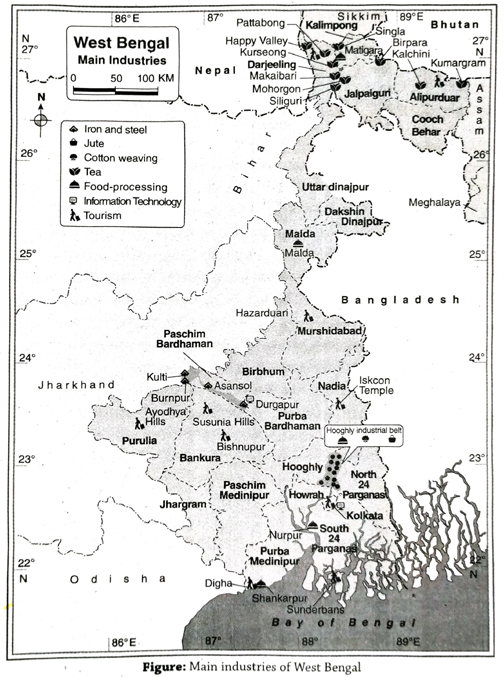
- Food processing industry: Food processing industry has developed in West Bengal due to its great demand. Kolkata, Shankarpur, Dumdum, Barasat, Malda are the main food processing centres in West Bengal.
- Tourism industry: Tourism industry has developed around various centres like religious places, hilly areas, sea beaches, educational centres, big cities, historical places, etc. Important tourist places of West Bengal are-Kolkata (Victoria Memorial, Alipore Zoo, etc.), Sundarbans, Digha, Darjeeling, etc.
- Information technology industry: This industry has developed in West Bengal and holds an important position in the state. The Electronics Complex (Software Park) of Salt Lake near Kolkata is famous and further development of this industry is taking place here.
- Geographical factors: Main geographical factors that help to develop iron and steel industries in West Bengal are as follows-
- Accessibility of raw materials: Raniganj, Andal, etc. of Paschim Bardhaman are important coal mine of West Bengal. Jharia, India’s largest coal mine is located near West Bengal. Thus coal are easily available in this region. In addition to this iron ore and limestone are also available in this region which helps to develop iron and steel industry in West Bengal.
- Accessibility of water: Sufficient supply of water is essential for iron and steel industry. Water of river Damodar is easily accessible to the iron and steel industry of West Bengal.
- Supply of energy: DVC (Damodar Valley Corporation), Maithon, Tilaiya, Panchet helps in hydroelectric and thermal power generation which facilitates the iron and steel industry of West Bengal.
- Economic factors:
- Abundance of labour: Cheap and skilled labour is available in the outskirts of West Bengal, Jharkhand, Bihar and Durgapur which helps to develop iron and steel industry.
- Well-developed communication system: This industrial centres are connected with Eastern Railway and Grand Trunk Road for import of machine and export of materials. This region is also connected with Hooghly industrial belt and Kolkata port via canals of the Damodar valley. It helps in import and export.
- Demand or market: The demand of the Durgapur-Asansol and the Kolkata industrial belts lead to industrial development.
- Financial investment: Investments in small-scale industries are of medium range. However, the overall financial investment is quite large indicating the importance of such industries.
- Employment: Many people are employed in small-scale industries which have led to the economic development of West Bengal. About 20 lakh people are engaged in the leather industry alone.
- Huge exports: A large market has developed for the products of the smallscale industries both in India and abroad. Thus, a huge amount of foreign exchange is earned from this industry. Items like leather goods, silk, cotton textile, gold jewellery, ceramic products, etc., are especially exported.
- Development of domestic trade and commerce: As a result of the flourishing small-scale industries, domestic or internal trade and commerce have increased. It is helpful for economic development of the country.
- Increase in infrastructure: Roads, electricity, water supply and other infrastructural facilities have developed around any area where small-scale industries are developing.
Short Explanatory Answer Type Questions
- Availability of coal from Raniganj and Jharía coal mine;
- Accessibility of iron ore from Noamudi, Gua Jharkhand and Gorumahisani, in Badampahar in Odisha;
- Available of other raw materials such as limestone (Birmitrapur), manganese (Gangpur) and dolomite;
- Abundance of water from Damodar and Barakar river;
- Availability of power resources from Durgapur and Mejia thermal power plant etc.
- Unavailability of raw material when required: Since only coal is available in West Bengal, other raw materials of iron and steel industry have to be brought from Jharkhand and Odisha. Thus raw materials are not always available as needed. It results in low productivity.
- Lack of modern technology: Lack of modern technology and equipments are the main problem for the development of iron and steel industries in West Bengal.
- Unavailability of adequate skilled labour: Although there are abundance of labours in West Bengal but number of adequate skilled labour is very less. It is one of the major constraint for development of iron and steel industry.
- Lack of infrastructure: Infrastructure of the tourism industry is very underdeveloped. The roads, houses and connectivity are in dismal condition.
- Lack of security: The main problem of the industry is lack of proper security.
- Lack of maintenance: Historical statues, buildings are ill maintained. It is one of the major problem of tourism industry.
- Tourism fair: Foreign tourists are interested in tourism fairs that are held here.
- New tourists spots: New tourist spots are being explored for development of more tourist destinations.
- Infrastructural development: New hotels, resort are being constructed to facilitate the growth of industries in this state. The infrastructural development with government aid will help the industry to develop further.
- Lack of extensive land: Land problem exists in Kolkata and its surrounding areas where the industries are to come up. Land is either scarcely available or prices are too high.
- Lack of infrastructure: The lack of infrastructure increases the problem of this industry.
- Disruption in the flow of work: A continuous interaction with the western countries throughout the day and even at night is required in case of the information and technology industry. However, certain factors like strikes, road-blocks, disputes regarding law and order disrupt this interaction, thereby causing hindrance in the flow of work.
- 1 acre-25 acre land have been handed over to 41 companies in Rajarhat.
- The ‘Look East’ policy has helped in the growth of the industry.
- The SEZ have been formed for this industry.
Short Answer Type Questions
Multiple Choice Type Questions [MCQ type]
Write the correct answer from the given alternatives
Very Short Answer Type Questions
Answer in one or two words
TOPIC – H
City, Port and Tourist Place
Long Answer Type Questions
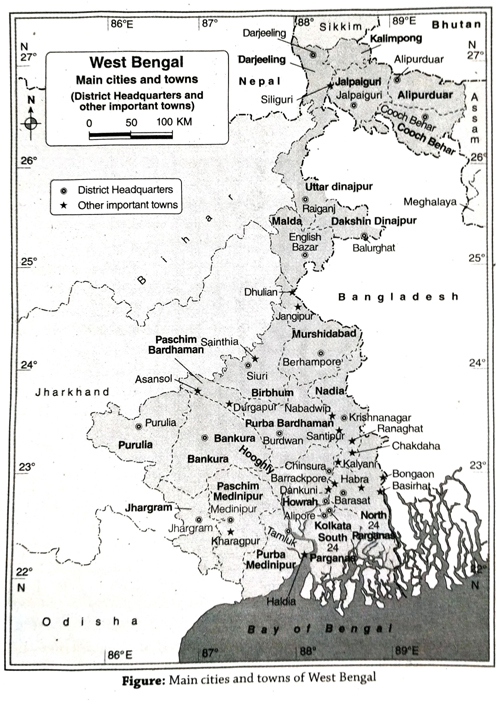
- Location: The capital of West Bengal, Kolkata is situated on the left bank of river Hooghly about 130 km inland from the mouth of river Ganga. This is one of the most significant cities in India.
- Year of establishment: Job Charnock, the governor of the East India Company established the city of Calcutta on August 24, 1690. The three villages of Sutanuti, Govindapur and Kalikata were united to form this city. Calcutta was the capital of India under the British rule till 1911. In 2001, the government of West Bengal decided to change the name of Calcutta to Kolkata officially.
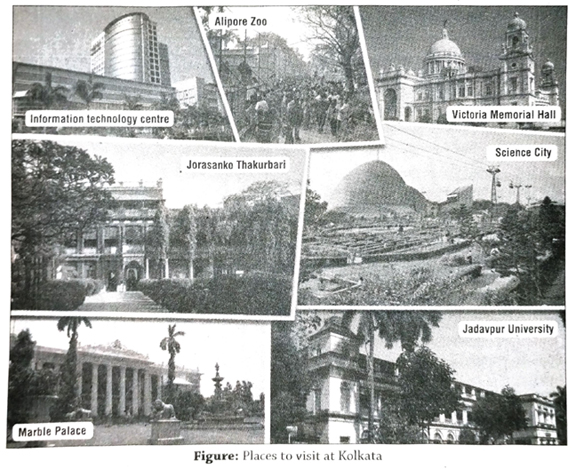
- Importance of the city of Kolkata: Kolkata is a very important city. Some of the important features of Kolkata are as follows-
- Commercial capital: Having an area of about 185 sq. km, Kolkata is India’s main commercial centre and the capital of West Bengal.
- City of Palaces: Kolkata boasts of having quite a number of beautiful palaces and heritage buildings (like, Marble Palace of Raja Rajendra Mullick in north Kolkata, Rabindranath Tagore’s house in Jorasanko, Palace of Sovabazar, etc.). This is why Kolkata is known as the ‘City of Palaces’.
- Population: Kolkata is one of the most important cities of India and the city’s population is about 4496694 (2011) and the population density is about 24306 persons per sq. km (2011).
- Centre of education, culture, trade and commerce: Kolkata is the main centre of education, culture, trade and commerce of east and north-east India.
- Industrial centre: Many industries have developed with Kolkata as its centre, like, jute industry, engineering industry, textile industry, paper industry etc.
- Centre of communication: Kolkata is the headquarter of the eastern and south-eastern railways. Dumdum, the only international airport of east India, is in Kolkata. National Highways like NH 2, NH 34, NH 35 and NH 6 all pass through Kolkata.
- Others: Other significant features of Kolkata are-(i) The only underground metro railway in eastern India is located here. (ii) Kolkata is the main port of West Bengal. (iii) The popular tourist spots of Kolkata are-Museum, Alipore Zoo, Victoria Memorial Hall, Birla Planetarium, Science City, etc. (iv) As per the book entitled ‘City of Joy’ by the famous author Dominique Lapiere, the people of Kolkata are ever-happy in spite of all the sufferings endured by them. That is why it is called the ‘City of Joy’.
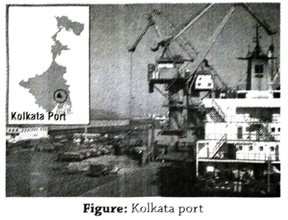
- Control over trade: Kolkata port has a very significant role in the economy of West Bengal and even north-east India as well as Nepal and Bhutan. The exports and imports of this vast region are all handled by this port.
- Earning foreign exchange: Since international trade is carried out through this port, the city earns foreign exchange.
- Aid to industries: Products of West Bengal like jute products, coal, tea (from Assam, Darjeeling), iron-ore (from Bihar and Odisha), mica, etc., are all exported from this port.
- Aid to agriculture: Fertilisers, pesticides, equipments, etc., required for agricultural practices are imported through this port.
- Employment opportunities: Lakhs of people are either directly or indirectly influenced by this port for getting employment opportunities in the agricultural, industrial, trade and commerce sectors, etc. Besides, a large number of people also get employment as labourers within the port area itself.
- Development of transport: Taking advantage of the Kolkata port, a good network of roads, railways and water transport have developed not only in West Bengal, but also throughout north-east India.
- Import of food crops: Since West Bengal is not totally self-dependent on food crops produced in the state, a lot has to be imported through the Kolkata port.
- British interest: The port of Kolkata was established in the nineteenth century during the British period. They established it on the banks of river Hooghly in order to facilitate transport of industrial raw materials, defence equipments, etc. to India.
- Navigability of Bhagirathi-Hooghly river: Since the depth of the river is more and navigability of this river is quite high, ships could ply smoothly through this river to the sea.
- Resource-rich hinterland: The Kolkata port has a huge hinterland encompassing almost the whole of eastern India. This region has rich natural resources like tea, jute, rice, etc., (agricultural) as well as coal, iron ore, mica, etc., (minerals), along with forest-based resources. Besides, the established industries of tea, jute, engineering, cement, paper, etc., have made this region densely populated.
- Availability of labour: Kolkata being a densely populated metropolis, labourers, required for port activities are easily available.
- Developed transport system: Kolkata is linked to all parts of eastern India through a well-developed transport network like south-eastern railway, national highways (like NH 6 and NH 34) etc.
- Conducive physical environment: The areas in and around Kolkata have the advantage of having flat places and delta, congenial moderate climate, etc., which are all conducive to the development of a port.
- Location of centre of trade: Kolkata being the main industrial and trade centre of eastern India, has naturally developed as a port.
- Decrease in navigability of Kolkata port: Due to continuous siltation on the river bed over a long period of time, the river bed has risen and therefore navigability has decreased. As a result, ships cannot ply much inland from the sea through this river.
- Meandering nature of river: Numerous meanders of the river from its mouth to the Kolkata port, hinder the smooth plying of big ships inland.
- Presence of huge sandbars in the river: The river has about 14-15 big sandbars stretching from the mouth of the river to Kolkata port. This is why large ships cannot enter Kolkata port easily.
- Lack of space and infrastructure in the port: Due to lack of space, many ships cannot be anchored at the same time. Lack of jetties also hamper loading and unloading of larger quantities of materials from ships.
Short Explanatory Answer Type Questions
- As a support to help the Kolkata port: The importance of Kolkata port has decreased since the navigability of river Hooghly has decreased due to siltation. As a result, big ships are not able to enter the port. This is the reason why the port of Haldia has been established at the junction of Hooghly and Haldi rivers.
- Easy availability of land: Easy availability of land has facilitated infrastructural development of the Haldia port.
- Fulfilling the demand for trade and commerce: The import and export of raw materials and products through Haldia port fulfills the demand for trade and commerce and this helps in the development of this port.
- Educational and cultural centre: Proper educational and recreational facilities enhance the growth of a city. People are also attracted to the cultural centre of a region, that helps to develop a city. Example-Shantiniketan.
- Tourist centre: A famous tourist spot always attracts people from different places. It helps to grow restaurents, lodges and other business opportunities that leads to origin of a city. ExampleDarjeeling.
- Commercial centre: A commercial centre always tends to grow business and supports employment, that helps to develop a city. Example-Haldia.
- Industrial centre: An industrial centre always tends to increase productivity that increase employment facilities and leads to population growth. As a result, a city develops. Example-Asansol.
- Mining centre: Cities may also develop around mines, because of employment opportunities and other socio-economic facilities. Example-Raniganj city around coal mine.
Short Answer Type Questions
Multiple Choice Type Questions [MCQ type]
Write the correct answer from the given alternatives
Very Short Answer Type Questions
Fill in the blanks with suitable words
If the statement is true, write ‘T’ and if false, write ‘F’ against the following
Answer in one or two words
Follow on Facebook page – Click Here
Google News join in – Click Here
Read More Asia News – Click Here
Read More Sports News – Click Here
Read More Crypto News – Click Here